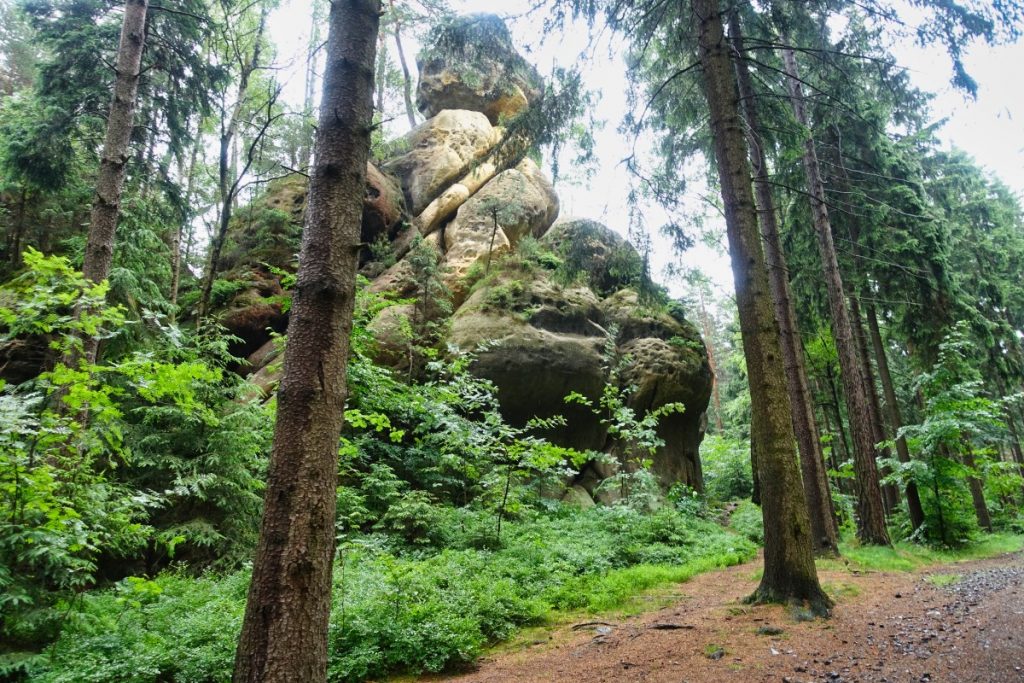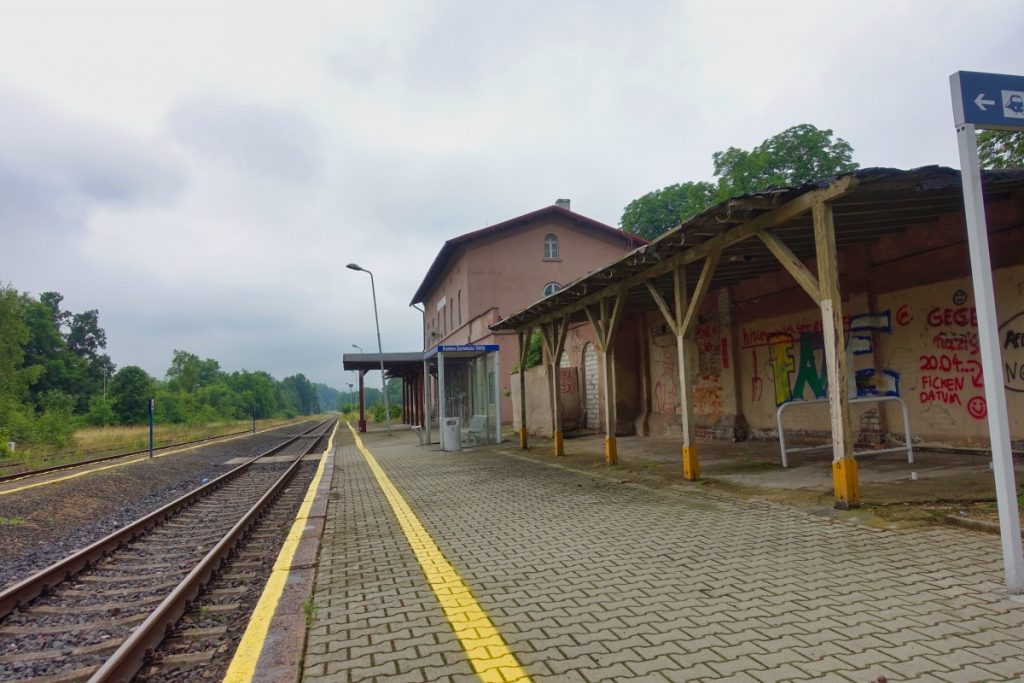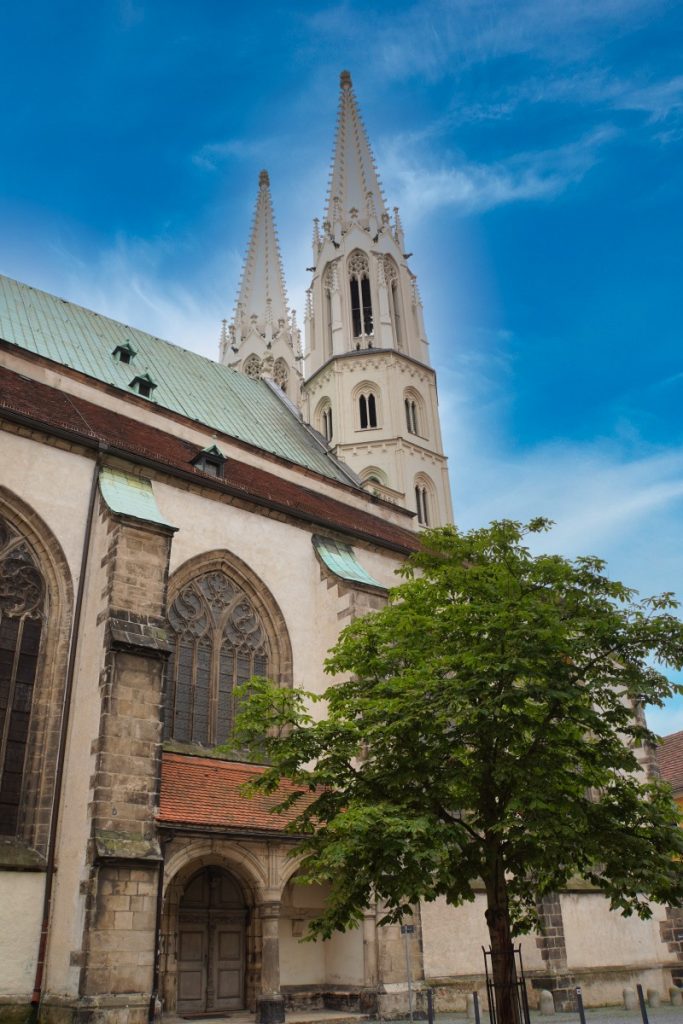Pilgrimage on the Via Sacra – for me it went for the first time on pilgrimage in Upper Lusatia: from Oybin to Görlitz in three stages with visits to sacred sites, on foot and by bike. Three wonderful and varied days that made me want to go on further adventures.
What is pilgrimage?
Pilgrim comes from the Latin and means as much as “to be in the stranger”.
People have been going on pilgrimage for a very long time. With the development of churches in Jerusalem and other places in the Holy Land, Christian travelers were offered new destinations to strengthen their faith.

In the Middle Ages, people went on pilgrimage to be freed from their sins or to fulfill a vow or an imposed penance. They followed very strict rules and regulations. The main destinations were Rome, Jerusalem and Santiago de Compastelo. The routes were covered on foot or by means of transportation. The pilgrims often stayed in simple hostels or monasteries.
During the Reformation, the trend changed. Pilgrimage was ridiculed and compared to selling indulgences, and in some countries it was even banned.

Today, pilgrimage is also practiced as a form of walking and is in line with the trend of the times. The Roman Catholic Church maintains and promotes the custom of pilgrimage to shrines. Marian pilgrimage sites such as Lourdes and Fatima were added to the existing destinations. The most famous Christian pilgrimage route today is the one to Santiago de Compostela, the Way of Saint James. But people do not go on pilgrimage just to visit church places. For many pilgrims it is a “back to themselves”, a recognition of their own limits and the experience of nature. Some go on pilgrimage because it’s “in,” others because it’s a decelerated way of traveling. Whatever the reasons of the pilgrim, in any case he experiences a completely different view of a region through the way of traveling.
Via Sacra
The pilgrimage on the Via Sacra is a church, culture, art, history and politics trip all in one. The 550-kilometer route runs along old trade routes in the border triangle “Germany-Poland-Czech Republic”. In total, it connects 20 stations with religious and art-historically interesting cultural monuments. The route is identical in sections with the Via Regia and the Way of St. James.

Stations of the Via Sacra
- Zittau (D): Small and Large Lenten Cloth
- Oybin (D): Castle and monastery
- Herrnhut (D): Evangelical Brothers’ Unity
- Cunewalde (D): Village church
- Bautzen (D): Cathedral St. Petri with cathedral treasury
- Panschwitz Kuckau (D): Cistercian abbey St. Marienstern
- Kamen (D): Kamenz altars
- Görlitz (D): Holy Sepulcher, Stations of the Cross, Evangelical Church of St. Peter and Paul
- Ostritz (D): Cistercian Abbey of St. Marienthal
- Krzeszów (CZ): Cistercian monastery complex Krzeszów
- Broumov (CZ): monastery
- Krummhübel (PL): Wang stave church
- Jelenia Góra (PL): Church of the Holy Cross
- Hejnice (CZ): Church of the Visitation of the Virgin Mary
- Liberec (CZ): Church of the Holy Cross, monument to the victims of the Shoah
- Český Dub (CZ): St. John the Baptist Church of St. Zdislava
- Mnichovo Hradiště (CZ): chapel of St. Anna
- Jablonné v Podještědí (CZ): Basilica of St. Lawrence and St. Zdislava
- Horní Police (CZ): Archdeanery, pilgrimage church
- Rumburk (CZ). Capuchin monastery with Loreto Chapel
So far, the route is not yet separately signposted. However, as you can see from the listed stations, it leads across the borders. One discovers sacral buildings and art treasures of the region and learns a lot about the Saxon, Bohemian, Silesian and Sorbian roots of the population. The motto of the Via Sacra is ” Travel without borders – through centuries – for reflection”.
Pilgrimage on the Via Sacra through Upper Lusatia
I spent three days on the Via Sacra in Upper Lusatia, from Oybin to Görlitz, and was thus able to walk a small section of the 263 kilometer long route in Germany on pilgrimage. For me, a wonderful experience in which I experienced a lot.

Day 1: Pilgrimage from Oybin to Zittau
The first day of the pilgrimage on the Via Sacra begins with a visit to the ruins of the castle and monastery Oybin. During an exciting guided tour, I get to know a place steeped in history and learn a lot about the region of Upper Lusatia. In my article about Oybin you can learn more.

Zittau Mountains
Back in the village, the route goes along various hiking trails through the Zittau Mountains. The exact course of the route can be followed very well on the map.
Somewhat difficult conditions, it rained a lot and the ground was often quite slippery, let us run a comfortable pace. Just the thing to discover the beautiful landscape.

The first point of interest is the chalice stone (natural monument) with its height of 18 meters. It is made of sandstone. The peculiar mushroom shape is due to the effect of wind abrasion and erosion on the different hard sandstone layers. The stone is a popular climbing point in the Zittau Mountains.

The next port of call is the rock formation called Shell Hall. Especially in our hiking weather with the low-hanging clouds, the place looked mystical.

Through dripping trees we followed the path to the Scharfenstein. There you could climb a staircase and should have a fantastic view in good weather. I could save the way on this day, there were only clouds to see. Also the Bohemian view, our next point of call, one had to believe that one could see something in the valley. Actually very sad, but nevertheless I really enjoyed the way. I liked this rainy and hazy mood between the rocks.

Finally we reached the potter, which is located at 580 meters above sea level. Just the right place and the right time for a snack. A few days a week a restaurant is open here, we were self-catering on this day and made ourselves comfortable at one of the covered tables. The rock formations of the Töpfer have imaginative names like “Brooding Hen” or “Little Turtle”. The summit cross was hidden in the fog and the otherwise quite popular place was almost empty.

Way to Zittau
After a refreshment, we continued our pilgrimage in the direction of Teufelsmühle. We covered the rest of the way to Zittau with the Zittau narrow-gauge railroad, which stops there at a small station. In the weather a good decision, the way of the Via Sacra to Zittau was still a few kilometers far.

In Zittau, the next highlight of the Via Sacra was already waiting for us. We visited the Zittau Lenten cloths. These very old cloths were used to cover the altar during the 40-day Lent. You can read more about them in my article about the Zittau Lenten Cloths.

Day 2: Pilgrimage on the Via Sacra from Zittau to St.Marienthal Monastery
After a good breakfast, the second day of the pilgrimage hike on the Via Sacra starts in Zittau. A hike of almost 20 kilometers leads to the monastery St.Marienthal.
As you can see on the map, the route is very flat except for the last kilometer. Here is a little tip: We have not been the last kilometers along the Neiße on the road. Who would rather be on the road without the climb, simply runs the Neisse valley further to the monastery.

The path through Zittau went through some residential areas and later a hiking trail along an industrial area. The path was signposted, but partly quite overgrown. The Neisse accompanied us and so you could enjoy the river landscape.

Hirschfelde
After about 10 kilometers we reached the village of Hirschfelde. From the outskirts of the village, the “Historic Hirschfelde Industrial Trail” leads through the village. On information boards you can learn a lot about the region.


In the village we passed numerous quite differently well-preserved half-timbered houses. The half-timbered house is a special type of house that combines log construction, half-timbering and solid construction. In Upper Lusatia there are still more than 6,000 half-timbered houses.


Here we were lucky to get a great snack. In the marketplace, the organized meal awaited us. In the village itself I saw no possibility for a stop in a restaurant or beer garden, only a supermarket at the end of the village.

With a full stomach, we made another detour to the church in Hirschfelde. Here we discovered the statue of a pilgrim in the cemetery, which was just restored.
Continue along the Via Sacra
Via Rosenthal we reached the Neisse Trail. Here the Neißeradweg runs along the river. Especially on weekends it can get quite crowded here.

At Wolfsgraben we left the well-maintained path and now hiked uphill and downhill through a beautiful forest area.
Shortly before our destination, the monastery of St. Marienthal, we returned to the Neisse Trail, which leads directly through the monastery grounds. For us, after almost 20 kilometers, the day ended with a small tour of the monastery before we could move into our rooms in the guesthouse.

The monastery of St.Marienthal with its beautiful monastery church and the garden of bible plants is one of the sacral places of the Via Sacra. Here you can find accommodation in different price ranges during your pilgrimage and get a rich breakfast in the morning. If you want to know more about the monastery, you can read my article.
Day 3: Bike pilgrimage from St.Marienthal Monastery to Görlitz
The third and last day of my pilgrimage begins in the monastery St.Marienthal. Here you can rent bikes and discover the region.

We will go on a bike pilgrimage and cover a distance to Görlitz, which can be done well in one morning. On foot you can also do the distance well in one day.
From the monastery St.Marienthal we first go through the town Ostritz. After we had a look at the market place and the beautiful town hall, we drove to a special feature of the place.
The station is located on the other bank of the Neisse River and thus in Poland. Here runs the regional train, which also stops in Zittau. The platform is reached via a small pedestrian bridge, where two border pillars draw attention to the fact that you are leaving one country and entering another.


On the way to Leubna
The bike path is well signposted and leads us in the direction of Leubna. Here we discover the Kellbrunnen to Leubna.
Leubna is a district of Ostritz and stretches from south to north over a length of about 1.3 kilometers on both sides of the former Zittau-Görlitzer Heerstrasse and today’s Bundesstrasse 99.

The place was first mentioned in 1326 in a deed of donation to the monastery of St. Marienthal as Lubil. In 1664, the then owner of Nieder-Leuba, Wigand von Uechtritz auf Steinkirch, had the spring flowing along the road enclosed and built over with a hall. His family coat of arms decorates the small hall. A drinking ladle was placed there, with which passing travelers could draw water. It is from this ladle that the well got its name. The water is good to drink and it is a nice refreshment on the way to Görlitz.

Not far away, we spontaneously decide to make a small detour across the Neisse River into Poland. In Radmeritz is the moated castle Joachimsthal and we hope to catch a castle view.
Jáchymov moated castle
A private path lined with ancient lime trees leads to a small bridge that leads to an island. A large gate with a coat of arms prevents you from entering the premises.
Joachim Sigismund von Ziegler und Klipphausen, the unmarried chamberlain of August the Strong had this estate built. He wanted to create a convent for the care of single, noble women of Upper Lusatia and neighboring areas. He invested his entire fortune in the facility, which became the first of its kind in the Electorate of Saxony and its neighboring countries. Twelve unmarried Protestant and at least four generations of noblewomen from Upper Lusatia and neighboring areas were allowed to move in. However, only if they had got into economic difficulties through no fault of their own. The women were prepared for their future life as wives, but could also live in the monastery forever.

Small fact on the side – the house has:
- 12 chimneys on roof – corresponds to the number of months in a year
- 52 mighty doors in the castle – corresponds to the number of weeks in a year
- 365 windows – corresponds to the number of days in a year
What might the master builder have been thinking?
Unfortunately, you can not get onto the site and so only a view over the walls remained. Who would like to see something more, should look at the drone flight.
Onward journey to Görlitz
The bike path led us further to Görlitz. The route is relatively flat and is very easy to ride.
Once we arrived in Görlitz, we made a detour to the Landskron Brau-Manufaktur and quenched our thirst with a beer. After that we went to the train station. There our luggage was already waiting and the bikes were brought back to the monastery St.Marienthal.
For me it went now to one of the sacred places of the Via Sacra. The Church of St. Peter and Paul (St. Peter’s Church) is one of the highlights of the Via Sacra pilgrimage route. A beautiful church with an extraordinary organ that you should definitely visit.

Disclosure: The pilgrimage hike took place as part of a press trip to Upper Lusatia. The article was written independently of this.








Leave a Reply